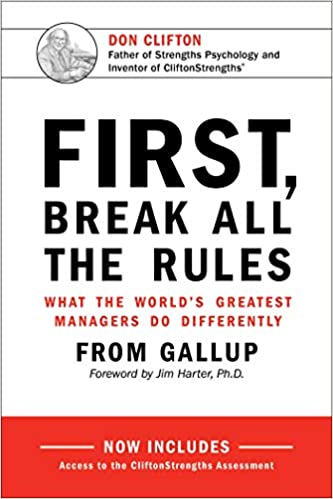GREAT BOOKS

Brett Dwyer writes:
This is a recommended read for any manager, no matter your department or level. It’s relatively conceptual, rather than having step-by-step instructions. But it will certainly stimulate ideas, help you understand some of the challenges you’ve been battling with, and in general, push you to be a better manager.
My takeaways were:
- That leadership and management are two different things. A good leader is not necessarily a good manager, and vice versa (and this is ok). Managers look inward towards the organisation, whilst leaders look outward towards the marketplace.
- Conventional wisdom tells us to devote extra time to helping the employees that are struggling, when in reality we should be spending as much extra time as possible with the high performers; they can go from great to excellent with the right mentoring.
- You can’t change someone’s behaviours (or, it’s very difficult, at the least). Managers can be prone to mistakenly believing (or hoping!) they can.
- It’s also common to see superstars placed in teams with the weaker performers – the idea being that it creates the best balance. However, putting superstars with other superstars is the way to go; the results will be incredible.
- It’s ok to play favourites. Not everyone is created equal. In fact, the fairest way to act is to play favourites.
- There’s a hierarchy of needs that stimulate a loyal workplace. It starts with basic elements that suggest employees clearly understand what they get from their role and then what they contribute, followed by higher-order ideas about whether they belong and finally, how can they grow. It’s important to tackle these from the ground up, basics first.
- I did find the authors definition of “Talent” versus skills and knowledge a little confusing – but I was still able to get the gist. Some things that are needed in order to excel in a particular job cannot be learned. Rather, it’s just an inherent trait of that particular person.
- Focus on each person’s strengths, and manage around their weaknesses. Don’t try to fix the weaknesses.
- Don’t treat people the way you would like to be treated. Treat them the way they would like to be treated. (Ask them!)
- Using bands of pay for each role (eg: $80,000 – $150,000) makes sense. The best salesperson could certainly be paid more than their manager. (And in addition, the salesperson should not be “promoted” into management if it will not be a good fit for them.)
- Structure your regular check-ins with the team, and keep notes from these meetings. However, much of the responsibly about tracking progress towards goals should lie with the team member.
We’d love to hear what you thought of this book! Please leave your comments below.

Leave A Comment